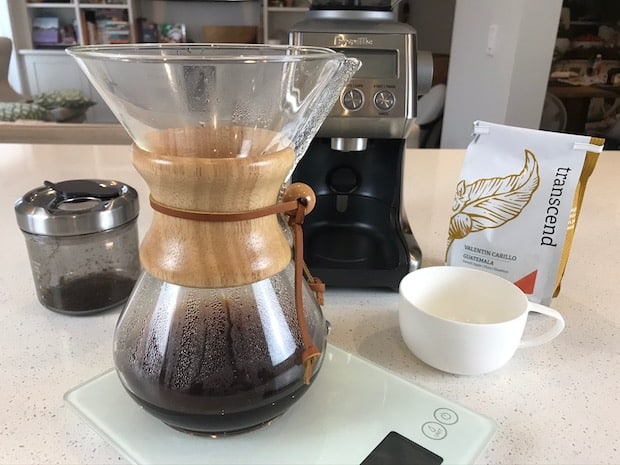Just so you know, as an Amazon Associate we earn from qualifying purchases made via bold red links, buttons or images.
Last Updated on December 10, 2023
The Chemex is as simple and elegant a coffee brewer as you will find.
It also makes terrific coffee.
Dr. Peter Schlumbohm, an immigrant chemist from Germany, invented the Chemex in 1941. At the time, the U.S. government was restricting the use of metal, rubber and plastic in private manufacturing, because those materials were needed for the war effort.
Dr. Schlumbohm made the most of what was left. His brewing device, made entirely of glass, wood and leather, now has a permanent place in the Museum of Modern Art and in the hearts of coffee lovers worldwide.
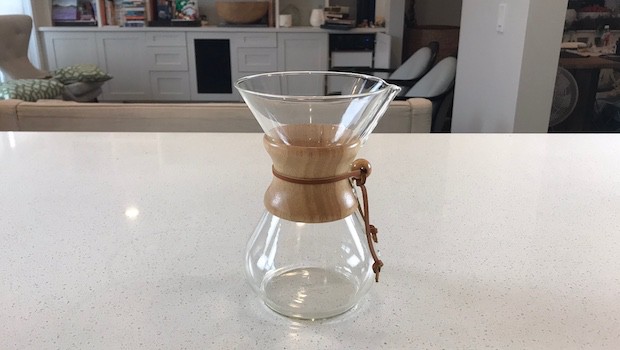
The brewer’s hourglass curves, wooden collar and leather thong have turned up in James Bond novels (From Russia, With Love) and graced Don Draper’s kitchen on Mad Men. But the Chemex is much more than pop-culture eye candy. It is the Porsche of pour-over coffee brewers, known as much for performance as its good looks.
Much of the credit for that should go to Chemex’s proprietary filter, which is 20-30 per cent thicker than a typical filter. This removes most of the oils and all the sediment from the coffee, yielding a remarkably clean cup. It also prolongs the extraction time by restricting the flow of water thorough the coffee grounds. As a result, the Chemex method pulls flavors out of coffee that drip brewers and other pour-over methods simply cannot.
Let’s show you how to do it.
How a Chemex works
For all its uniqueness, the Chemex is simply a pour-over brewer. That means it holds ground coffee in a filter, and you pour water over the coffee to brew.
Gravity wants to pull the water down through the coffee and out the funnel at the bottom into the carafe. However, two obstacles lie in the way:
- The beans
- The filter
It takes time for the water to trickle down through the grounds. The finer the coffee is ground, the longer it takes. And then the coffee has to get through the filter. This filter has smaller pores than most.
As you can imagine, things get backed up. This is where the magic happens. The hot water and the coffee mingle together in a slurry for a few minutes. As they do, the water extracts aroma and flavor compounds from inside the coffee bean particles and dissolves them. By the time it drips out the bottom, it is no longer water but coffee.
How to brew Chemex coffee
What you need
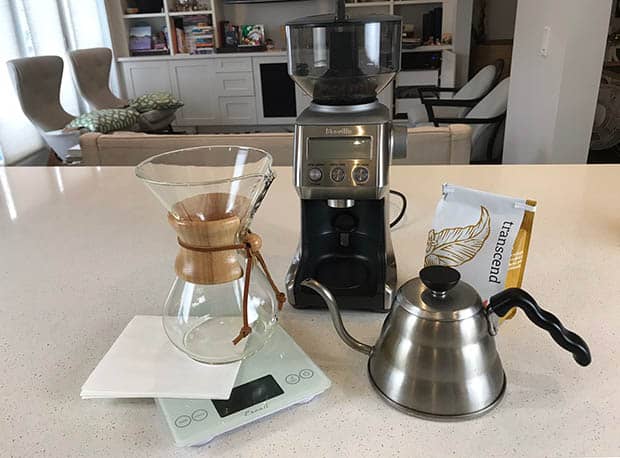
Chemex brewer
Chemex sizes are hard to figure out. I have a 6-cup brewer, which maxes out at exactly 920 mL or 32 fluid ounces of coffee. (The carafe is full when the liquid level reaches the bottom of the wooden collar; it is half full when it reaches the top of a small bump that protudes from the side of the glass carafe at its widest point.)
In my world, that’s four small coffee cups or two large mugs. I can’t explain why they call it a 6-cup.
Chemex also makes what it calls 3-cup, 8-cup and 10-cup brewers. Based on my 6-cup version, here’s what I assume you will get from each:
Chemex sizes
| Size | Metric volume | Fluid ounces | Cups | Mugs |
|---|---|---|---|---|
| 3 cup | 460 mL | 16 | 2 | 1 |
| 6 cup | 920 mL | 32 | 4 | 2 |
| 8 cup | 1.23 L | 43 | 5 1/3 | 2 2/3 |
| 10 cup | 1.53 L | 53 | 6 2/3 | 3 1/3 |
Gooseneck kettle
You can brew pour-over coffee with regular kettle, but it’s bound to get messy. I recommend a gooseneck kettle for greater precision and control, and less splattering.
Scale
Ideally, you’ll use a coffee scale or standard kitchen scale. If you don’t have one, I’ll give you some tips later for brewing Chemex without a scale.
Timer (optional)
Some people like to use a timer to ensure their pour falls within the recommended 3-5 minute range, but this is optional. Just pour slowly and steadily and I think you’ll be fine.
Burr grinder
I’m going to get a bit snobby here and insist you use a proper burr grinder for this. Yes, you can use a blade grinder in a pinch, but you’ll get wild variation in the size of your bean particles and very uneven extraction. You and your Chemex deserve better.
Chemex filter
I touched on the special qualities of the filters in my introduction, but I didn’t mention that they come in three shapes:
- circles
- squares
- half-moons (for 3-cup brewers only)
Circles are the easiest. Squares are the hippest. They all come in white (bleached) or natural color.
Before you brew
What kind of coffee should you use?
The best coffee for Chemex is of course a matter of personal taste, but specialty coffee lovers will tell you that this brewing method is particularly kind to delicate, acidic, single-origin coffees in a medium roast. If you would rather taste the character of the bean than the flavors of the roast, you’ve got the right coffee maker.
That said, if your roast is deep, dark and rich, Chemex can handle it.
Get in touch with our friends at Phil & Sebastian Coffee Roasters and let them know you’re breaking in a Chemex. They’ll sort you out. Shipping to the U.S. is free.
Coffee-to-water ratio
The Chemex coffee-to-water ratio should be about 1:17, no different than most other brewing methods. You can reduce this to 1:15 or 1:14 if you like it strong, or loosen it up a bit if you prefer the opposite. In our directions below, we’ll brew using 20 grams of coffee and 340 grams of water, which is exactly 1:17.
Grind size
The ideal Chemex grind size is coarser than you would use for your average drip coffee machine, but finer than you would use for French press. It’s actually quite similar to a percolator grind. You might have to eyeball it at first and adjust from there depending on how your coffee turns out.
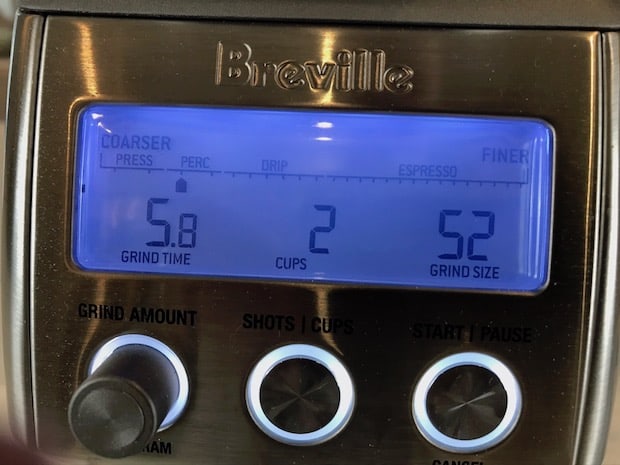
To help you out, we’ve listed our recommend grind settings for a number of popular coffee grinders.
Recommended grinder settings for Chemex:
| Grinder | Chemex setting |
|---|---|
| OXO burr grinder | 11 |
| Cuisinart burr grinder | 13 |
| Baratza Encore grinder | 27 |
| Breville Smart Grinder Pro | 52 |
| Capresso grinder | 11 |
| Hario grinder | 30 |
| Bodum grinder | 10 |
| Wilfa grinder | 27 |
Directions
I’ll take you through the process I use to brew a good-sized mug in my 6-cup brewer. You might need to adjust some of the measurements depending on how much you’re making, but the process remains the same.
Boil water
Fill your kettle with water and get it going. Once the water boils, turn the burner down to very low, or simply remove the kettle from the heat if you will be using the water without much delay.
At this point you might want to preheat your Chemex carafe with some hot water. This is one of our top tips for keeping Chemex coffee warm.
Prep filter
If you’re using a square filter like I am here, it’s not as complicated as it looks. They come folded in quarters, and you just want to open it at one corner so that you have a single leaf on one side and three layers on the other.
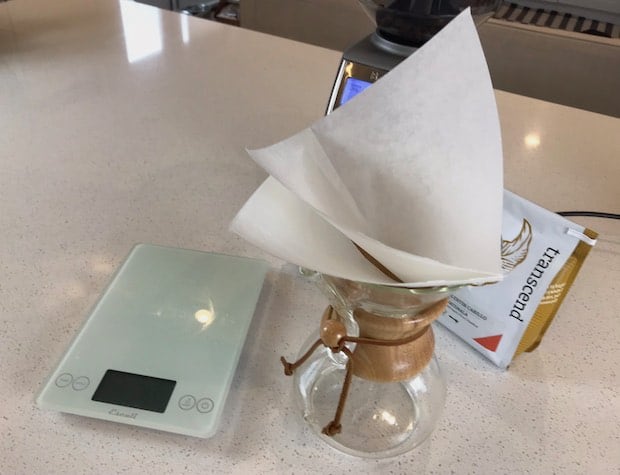
Place the filter into the top of your carafe so that the three-ply side faces the pouring spout.
Rinse filter and preheat carafe
Drizzle some of your hot water over the filter so that it soaks and clings to the glass. You want most of it damp. No need to obsess about wetting the top edges.
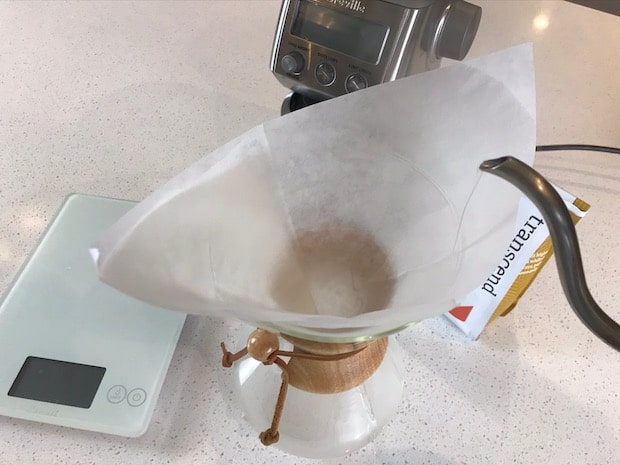
This rinse will help rid your coffee of any paper flavor, and it also warms the glass of the carafe to get it ready for the coffee.
Measure and grind coffee
Grind your coffee medium-coarse. For this recipe you’ll need to grind at least 20 grams.
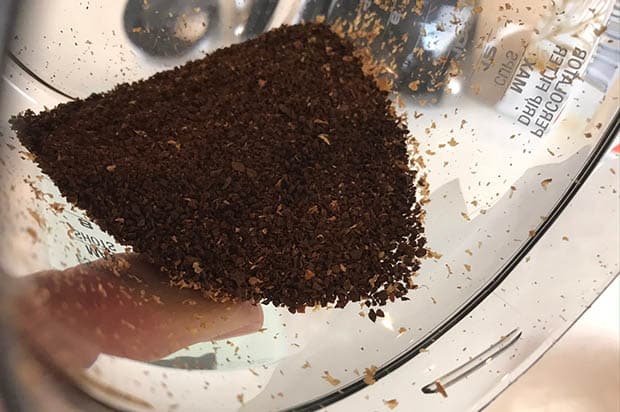
Then place the Chemex with the filter on your scale. Tare the scale back to zero and sprinkle in 20 grams. Shake the whole apparatus to level the bed of coffee, then return it to the scale and tare it back to zero again.
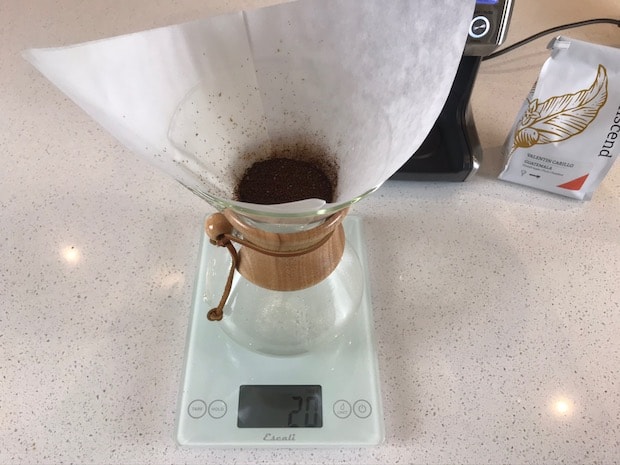
Bloom the grounds
Soak the coffee in the bottom of the filter with water that’s just off the boil, using 40 grams of water.
Whatever your weight of coffee, use twice as much water for blooming.
Give the water about 30 seconds to pull residual carbon dioxide out of the coffee beans, because you don’t want a lot of that CO2 in your coffee. If the beans are really fresh—roasted in the past week—they’ll have more carbon dioxide, so you can bloom for up to 60 seconds.
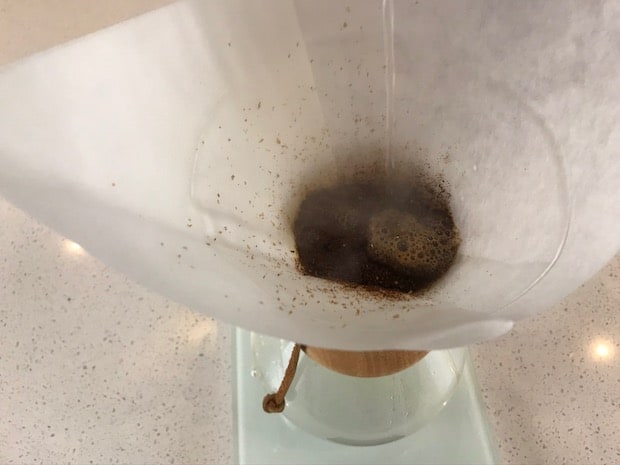
Pour
Pour water in two phases. The first phase will take you from 40 grams to 200 grams. Pour very slowly and steadily, starting in the centre of the coffee bed and moving outward in a circular motion, then back in. Try to focus on the grounds rather than pouring water on blank filter paper. The gooseneck gives you the control you need.
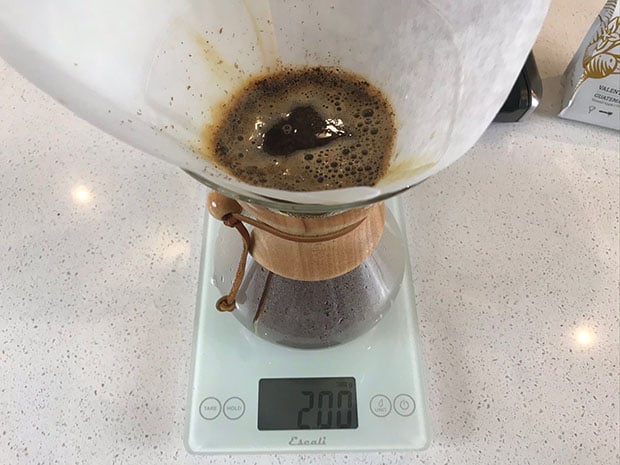
When you reach 200 grams, pause and let the water work its way down. When the water level is barely covering the surface, resume pouring the same way until you reach your final weight of 340 grams.
Pull your kettle away and let the coffee brew until drips are few and far between.
From your first pour until the coffee is done should take 3-5 minutes.
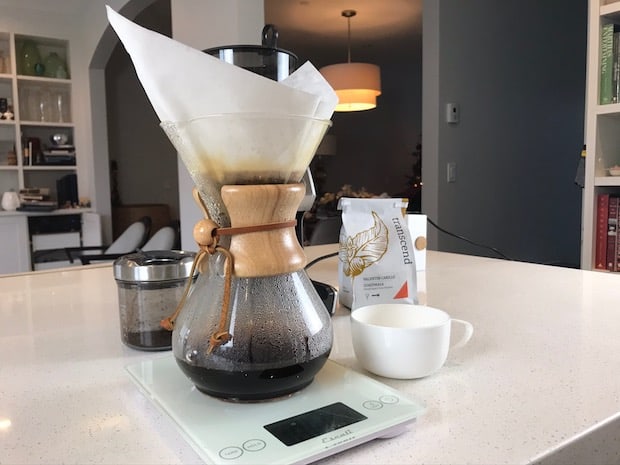
Serve
Discard the filter, which is compostable. Pour from the spout into your cup. (The action on the spout is very satisfying!). Enjoy your coffee.
Troubleshooting your brew
Hopefully, your coffee tastes great.
If not, it’s going to go one of two ways:
- Under-extracted: Weak, thin, grassy and/or sour
- Over-extracted: Harsh and bitter
Don’t worry, there are solutions for both. It might take a bit of practice.
Under-extracted coffee generally means one of three things (or a combination):
- The grind was too coarse.
- The coffee and water were not in contact long enough. This can be the result of a coarse grind, or of pouring too quickly.
- The water was not hot enough.
My first recommendation would be to go with a finer grind and do everything else the same. That’s usually the culprit. But play with those other variables if you’re certain you nailed the grind.
Over-extracted coffee generally means the opposite:
- The grind was too fine.
- The coffee and water were in contact for too long. This can be the result of a fine grind, or of pouring too slowly.
- The water was too hot.
Again, sort out the grind size first before you start tinkering with the other stuff.
Even if you’re satisfied with your first brew, you can learn a lot by playing around with these variables one at a time. Once you’ve got your process down and can get a good cup consistently, see what happens when you change the grind size or lower the water temperature. You might find something you like even better. And what works for one bean might not work so well for another. That’s the science of coffee.
How to make Chemex coffee stronger
Strength of coffee is determined by the coffee-to-water ratio. If 1:17 is too weak for you, just try increasing the coffee or decreasing the water. It’s the best way. When you get it the way you like it, remember the ratio.
How to make Chemex coffee without a scale
In case you haven’t guessed by now, I’m a big fan of precision when it comes to brewing Chemex coffee. That said, you can still brew it well without a scale.
Just remember that a typical coffee scoop (2 tbsp) holds 10 grams of coffee. So for this recipe, you would use two scoops (4 tbsp) to get your 20 grams. Then you would add 12 ounces (1.5 cups) of water in total, dividing it between two approximately equal pours.
Don’t sweat the measurements on the initial bloom. Just pour enough water in to get the entire coffee bed wet.
Multiply all these measurements accordingly if you’re brewing for several people.
To help you out, we have a coffee measurement calculator below. Just tell it how many cups you’re making, how big your cups are, and how strong you want your coffee. Then choose scoops or tablespoons for your ground coffee measurement, and ounces or cups for your water measurement. The calculator will do the rest and give you the answers at the bottom.
Coffee ratio calculator
Cleaning your Chemex
Once you’ve discarded your filter, all that’s left is glass and coffee. That’s easy to clean. Just pour out whatever coffee you can’t use and rinse the carafe well with water. If any drips have dried on the rim or the outside of the carafe, you can use dish soap and water to clean it.
That’s all you really need to do. Over time you may want to give your carafe a more thorough cleaning to prevent the glass from staining. We discuss in another post how to clean a Chemex more thoroughly.
You are now equipped with the knowledge to make great Chemex coffee. I hope you are also equipped with the gear. If you’re missing anything, here’s what I recommend:
- Chemex: 6 cup brewer
- Filters: Classic square Chemex filters
- Grinder: Breville Smart Grinder Pro
- Scale: Ivykin Digital Kitchen Scale
- Kettle: Cosori Electric Gooseneck Kettle
- Coffee: Subscription from Phil & Sebastian Coffee Roasters
Happy brewing!

